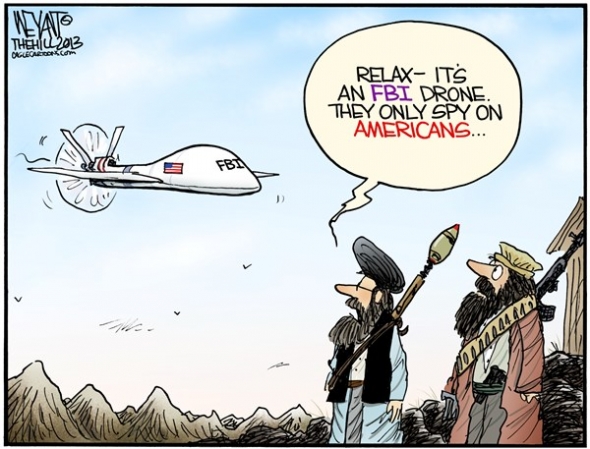And back in the day, every train had an “engineer” in the cab of the locomotive. Then robo-trains took over intra-airport service, and in the past decade they have appeared on subway lines in Copenhagen, Detroit, Tokyo, and other cities.
Quietly, automation has taken charge of many other life-and-death functions. It manages white-hot ribbons of steel that shoot through rolling mills. It guides lasers that sculpt the eye and scalpels that excise the prostate gland. It runs oceangoing freighters, the crews of which have shrunk by an order of magnitude in living memory. And, most obviously, it is mastering aerial warfare. Today, the U.S. military trains twice as many ground operators for its unmanned aerial vehicles (UAVs) as pilots for its military jets. Its UAVs started off by flying surveillance missions, then took on ground attack; now they are being readied to move cargo and evacuate wounded soldiers.
In the sphere of commercial flight, too, automation has thinned the cockpit crew from five to just the pilot and copilot, whose jobs it has greatly simplified. Do we even need those two? Many aviation experts think not. “A pilotless airliner is going to come; it’s just a question of when,” said James Albaugh, the president and CEO of Boeing Commercial Airlines, in a talk he gave in August at the AIAA Modeling and Simulation Technologies Conference, in Portland, Ore. “You’ll see it in freighters first, over water probably, landing very close to the shore.”
Later, when air-traffic control systems rise to the challenge, pilotless planes will carry stuff to your very doorstep. In the fullness of time, they’ll carry you.
Still, UAVs have yet to find a place in even the humblest parts of the aviation business—surveying traffic jams, say, or snooping on celebrity weddings. Such work has not yet been approved for routine purposes, even when the aircraft is small and controlled by a human on the ground—a man-machine meld that keeps a pilot in the loop. Why is it taking so long for the pilot to go the way of the elevator man?
Technical obstacles can be cited: Fully automated planes can’t yet visually identify nearby planes, and as for the remotely piloted ones, the civilian variety can’t communicate with ground stations, because they haven’t got enough bandwidth. “The name of your magazine is the underbelly of all the problems,” says Doug Davis, director of the unmanned aircraft program at New Mexico State University, in Las Cruces. “There’s not enough frequency spectrum. We have to compete for it with all these mobile phones and other demands.”
But technical problems are hardly the entire explanation. The military has proved this point time and again, by trusting automation to do things that few human pilots could do on a fair day and with a following wind. In a stealth aircraft, for instance, software fiddles from moment to moment with the flight-control surfaces; otherwise, the radar-eluding design would make the plane fall like a brick.
And for nearly two decades, automatic landing systems have been able to drop and stop a jet on the fog-shrouded deck of an aircraft carrier that’s barely twice as wide and three times as long as the jet’s wingspan—and the ship is moving. Meanwhile, the pilot sits in the cockpit, hands folded.
“Look, there’s no harder job for a pilot than landing on an aircraft carrier,” says Missy Cummings, a former jet jockey for the U.S. Navy and now an associate professor of aeronautics and astronautics at MIT. “It’s what Navy pilots have over those in the Air Force. And when I saw an F-18 land itself on an aircraft carrier, I knew my job was soon going to be over.” That was in 1994. Automation has gotten rather better since then.
In fact, the U.S. Army has now decided that if you can trust the life of a pilot to software, you can trust the life of a wounded soldier, too. It’s funding R&D into robotic medical evacuation vehicles. One such system, being developed by Piasecki Aircraft Corp. of Essington, Pa., and Carnegie Mellon University, is being designed around a system of sensors and software meant to launch and land a full-size helicopter on cluttered, unmapped ground and also fly the vehicle at low altitudes. Similar systems are under development in other countries. Israel’s Urban Aeronautics is experimenting with a pilotless medevac that uses four rotors shielded by cowling so that they won’t get tangled in shrubbery.
Given such advances, pilotless commercial flight is overdue, argues Cummings. Civilian UAVs could easily and profitably be deployed to survey infrastructure and carry cargo, she points out. And there’s no reason why software, alone or perhaps in conjunction with a quickly mobilized ground controller, couldn’t take over a piloted plane should something happen to both the pilot and the copilot. Already, she notes, an airliner’s software typically takes over flight seconds after takeoff, handles the landing—and most of what happens in between. The pilotst “babysits,” she says.
Of course, software that can meet only “most” of aviation’s challenges would hardly satisfy the afraid-of-flying landlubber. That’s why the pilot is still there, babysitting, until all the remaining kinks have been worked out. None of the problems are so bad as to prevent civilian pilotless planes from ever happening, but they are real, and they will have to be solved.
Food for thought and the most important part of the conversation is that in Europe, DHL has already initiated automated cargo flights. Imagine that….the future is here.
Have a good weekend, enjoy time with family and friends, and consider your options as we move forward with our series on the age of automation.
Robert Novell
January 16, 2015




